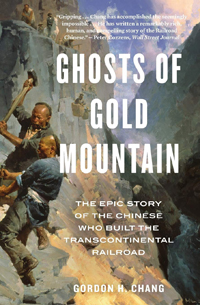 Gordon H. Chang, Ghosts of Gold Mountain; The Epic Story of the Chinese Who Built the Transcontinental Railroad (New York: Mariner Books, 2019), 312pp.
Gordon H. Chang, Ghosts of Gold Mountain; The Epic Story of the Chinese Who Built the Transcontinental Railroad (New York: Mariner Books, 2019), 312pp.
When Leland Stanford took a silver hammer and drove a golden spike into the newly completed Transcontinental Railroad on May 10, 1869, he celebrated the largest construction project in American history to that point, and the second largest in the world after the Suez Canal. And as the Stanford historian Gordon Chang shows in this definitive work of historical recovery, it never would have happened without the 20,000 Chinese laborers who comprised 90% of the workforce. These forgotten heroes became known as The Railroad Chinese.
The project began in 1864 while the Civil War still raged. Whereas the Union Pacific Railroad started in Omaha and built westward, Chang explores the "lived experience" of the Chinese who worked for the Central Pacific Railroad Company that started in Sacramento and built eastward. Although the CPRR's 690-miles of the western leg was only about half the length of the UP's 1086 miles, their task was far more complex and challenging. What those Chinese workers did staggers the imagination. The "challenges to construction at the time were almost impossible to measure. Think beyond human calculation."
The Railroad Chinese worked six days a week in three 8-hour shifts. All the work was done by manual labor. They blasted fifteen tunnels through granite mountains. They lived and worked at elevations up to 7,000 feet. Winter snow drifts could easily reach 30 feet, as skiers today can attest. The summer deserts of Nevada and Utah were sweltering. The supply chain of food and material was an organizational miracle. Violent racism was endemic (cf. Governor Leland Stanford's infamous speech about the "dregs... of an inferior race"). As many as a thousand Chinese died in the process. The pay? About a dollar a day (whites were paid more). And their reward? Not long after they finished, the rail workers were pushed to the margins of American history and society due to vigilante violence and legally sanctioned racism like the 1892 Chinese Exclusion Act.
When the CPRR and UP lines met in Promonotory Summit, Utah, they "forged a continuous road of iron across the entire country, making possible travel unprecedented in speed and scale." Travel time (not to mention safety) from the Atlantic to the Pacific was reduced from 3-6 months to one week. In a way, as Chang observes, the line connected Europe to Asia, and revolutionized the global economy. It helped to unite a nation divided by war. There are no extant materials about this human drama written by the Railroad Chinese. Chang recovers their story, and in his telling honors them not as passive victims, but as a resilient and resourceful people of remarkable agency.
Dan Clendenin: dan@journeywithjesus.net


